Owen K.C. Stephens's Blog, page 2
December 15, 2023
PC Roles for Starfinder — For Loosening the Math
One common objection to Starfinder can be summed up as “the Math is too tight.” Now there are a lot of ways of saying that — success is too rare, characters must be optimized to succeed, my spells don’t work often enough — but at the core it’s all saying the same thing. Starfinder is designed to make it difficult (well, the design shoots for making it impossible) for a character to be so good at any aspect of the game that they have no chance of failing an important check that is an appropriate challenge for their level.
(And, yes, operatives are *supposed* to eventually be unable to fail trick attack checks, since they can still miss with the attack roll even if it’s going to get extra dice if it hits.)
Put simply, some people want PCs to succeed more (and, by extension, NPCS succeed less) than the baseline Starfinder rules are designed to accommodate. And, as a play preference… that’s fine! (An associated play style preference is one where you take PCs of a given level, and throw hoards of significant foes of about their CR at them instead of 1-2. You still need PCs able to break the math curve to survive that, even if you don’t want PCs to have the overwhelming dominance of PC power you’d get by throwing hoards of foes with CRs 4 or more below the PCs’ level.)
There are lots of ways you can make that happen… including the optional rules of this article, “PC Roles.”
PC ROLES
A PC Role is a short, simple set of bonuses you give a PC to make them radically better at one thing. Even if a PC with a role is not optimized, within their role it’s unlikely any other PC without that role will match their effectiveness. Because the math of PC and NPC advancement are so closely matched in Starfinder, it’s not necessary for the benefits of a role to increase as a character gains levels.
A player selects a character role at 1st level, and this can’t be changed. While the roles have no prerequisites, in general it’s a good idea to elect a role that seems to be a good match for the character’s concept and class — being an Effects Expert can work for a broad range of classes from grenade soldiers to spellcasters, but it a terrible choice for a character with few or no options to force a foe to make a saving throw. Damage Dealer works for any combat-capable class, including operatives and mechanics.
For a higher-powered game (which might be desirable to compensate for not having enough players, or to create an even more epic feel to the campaign), a GM could even allow each PC to select to PC Roles. If the roles are in the same conceptual area (such as Damage Dealer and Tank, which are both straight combat focused), that PC is likely to overshadow all other characters when an encounter is focused on that concept
A mechanic with a drone applies the benefits of their role to both their own actions, and their drone’s.
Ideally, no PC Role is taken by more than one PC in a given group. The exception to this is if a GM builds a campaign with that concept included (such as running a group of starfighter pilots, and making them all Stellar officers).
The benefits from PC Roles apply to starship combat where applicable.
When a PC Role talks about doing something “normally,” it means without the benefits the skill role provides.

(Art by Grandfailure)
PC Role Descriptions
There could be dozens or PC Roles available in a campaign, but we’ll start with just 10.
Arcane Combatant
If you cast a spell as a standard action that has a saving throw, and is not noted as being ‘harmless,” and no creature is affected by the spell in any way, you make immediately take an additional standard action. You cannot cast a spell or use a spell-like or supernatural ability with this extra standard action.
Damage Dealer
You gain a +3 bonus to all attack rolls. If an attack of yours does less than its average damage, you may instead deal average damage.
Effects Expert
Any time you force a foe to make a saving throw (such as with a spell, class feature, grenade, or whatever), the DC of that saving throw is 3 higher than normally.
Healer
You gain the spells from the mystic healer connection as spell-like abilities. You can cast these on targets with a range of 60 feet. Treat your character level as your mystic level to determine which healer connection spells you know, and their caster level. You can cast the highest-level spell you gain from this role twice per day, the next-highest three times per day, and so on. If you expend a Resolve Point when you do so, you may cast these spells as move actions. Your mystic cure spell from this PC Role can cure Stamina Points, if you wish it to.
You also gain the the 0-level spells detect affliction, realign, and stabilize as spell-like abilities useable at will.
Skilla Gorilla
You gain a +3 bonus to all your skill checks.
Skill Money
Any skill check you could normally perform as a full action, you may instead preform as a standard action. Any skill check you could normally perform as a standard action, you may instead preform as a move action.
Speedster
You can take an extra move action each round. This move action can only be used to move, or adjust your equipment (such as pulling out or pulling away new equipment). You do not provoke attacks of opportunity by leaving a threatened space.
Stellar Officer
You gain a bonus to all starship combat skill checks equal to 3x the tier of the ship you are in, a +5 bonus to attacks with starship weapons, and you can attack with a weapon someone else has already attacked with this turn. You count as two crew, and can fill two separate roles (taking all the actions of each, but you cannot take the same role twice), including taking a role another character has that is not normally able to be held by multiple characters at once.
Tank
You gain +3 EAC/KAC, and +2 Stamina Points per character level. In combat, each round a foe could attack you, and doesn’t include you in any attack or offensive action, the foe suffers a -2 penalty to all its attack rolls and save DCs until the beginning of its next turn.
Unfaltering
You gain a +3 bonus to all saving throws, and +3 Resolve Points.
Support
I’ve been fighting cancer, recovering from a pulmonary embolism, and suffering through constant infections for most of 2023. Eventual surgery is the only way to remove the cancer… but that isn’t even scheduled yet, for various medical reasons. This fight takes money, bills are mounting, and my resources (of energy and money) are running thin. You can donate to my ko-fi, if you want to help.
There are cat pics there, too.
December 11, 2023
Practical Pastiche: TV Shows
“Practical Pastiche” is a series I expand on from time to time, offering drop-in names you can use in your home ttRPG campaigns to replace real-world organizations, places, groups, and anything else you might want to use in a fictional world without the baggage of using real-world elements.
TV SHOWS are often touchstones of modern life, and they can interface with ttRPG characters and campaigns in many ways. So whether you need a show to be boycotted by the Choco-Cola Company, a superhero to have a secret ID as a TV writer, or want to list what show a famous NPC media celebrity is the star of, these are the fictional series of fiction to use.
“Bleeding Ink”: Drama about a major newspaper facing the decline of print media. Tackles political issues, ethics in journalism, print vs video vs internet, and the risks of news as entertainment. Famous for the “rotating perch scene,” where one character leans or half-sits on a piece of furniture and talks to one or more other characters in the room as the camera rotates the POV constantly,
“BOLO”: And, of course, spin-offs BOLO: Baltimore, BOLO: Stockton, BOLO: Fugitive Recovery, and even foreign spinoffs such as BOLO: London, BOLO: Berlin, and BOLO: Saint-Jerome. The letters stand for “Be On the Look Out,” a police term. The original BOLO is a police procedural set in Chicago, and covers one precinct’s “war on crime,” with most episodes focusing on trying to find specific suspects. A huge franchise.
“Controlled”: Sitcom about a huge rent-controlled apartment in Oakland lived in by “Gamma Ruth,” a woman “so old they named a book of the Bible after her.” Gamma Ruth lets her 8 children, 11 grandchildren, and 4 great-grandchildren live in the massive apartment’s many bedrooms and salons rent-free, and pays a single dollar a month due to a rent-controlled contract. The building’s owner, Mr. Grundle, both wants to find Gamma Ruth in violation of the contract so he can raise her rent, AND wants to date one of her granddaughters. Hilarity ensues.
“Diplomacy Extreme”: A reality show where attractive people live together in a location with artificial scarcity, constantly form and re-form teams that vie for resources in various weird challenges, and make deals and alliances in an effort not to be “impeached” in a secret ballot that removes on contestant at the end of each episode (at which point all their previous votes in previous rounds are revealed). Last 3 people are then re-integrated with all previous contestants in the last episode, all the remaining 3’s votes are revealed, and the people removed in earlier shows vote for 1 of the 3 to win $1 million.
“Game of Empires:” Fantasy action/drama. Streaming company’s prestige fantasy series about a fantasy world thrown into turmoil when the High King dies without an acknowledged heir. Magic tends to be dangerous to use and more likely to make things worse than help, and there’s a lot of naked sexy women in most episodes, but it’s also genuinely compelling… at least for the first 6 seasons.
“Gang Stoppers”: Live drama where camera crews follow along with civilian patrol groups that try too pacify “The America, neighborhoods overrun by gangs, hoodlums’, and thugs.” The civilian patrol groups are mostly white, the people they try to detain with citizens arrests mostly aren’t. There have been a lot of lawsuits, but the show makes so much money it’s been on the air for more than 25 years.
“Nerd Friends With Benefits”: Half hour comedy. They’re young. They’re nerds. They’re… hot and horny? Dating/slice-of-life sitcom that tries to draw in the nerd market, but it often accused of mocking nerds rather than celebrating them.
“Tiffany’s Monster Hunting Service”: Supernatural/light horror/light comedy drama. Teen girl Tiffany Vannelle discovers the great-great-great-great-great-great-great-great-12th-century-grandmother she was named for was a monster hunter who founded a society to continue her work and, as the 7th daughter of a 7th daughter, she’s expected to run it someday. Since her monster-hunting training and duties leave her no time for babysitting, lawn-mowing, or seeing friends, she forms a teen branch monster-hunting agency so she can hang out with her “Buster Buddies” friends and make some money.
“Secret Sector”: An action/drama show about the world of private intelligence agencies, based on the concept of there being a Public Sector, a Private Sector, and then the Secret Sector. Follows two agents of the Red Harvest agency as they wrestle with spywork against both other private intelligence agencies and governments, as well as the dangers and ethical dilemmas of their jobs.
“Vaudeville Never Died”: A long-running late-night weekend comedy skit and music show with celebrity guest hosts each week, often just called VDN. Famously mocks itself for being unfunny. Opens each episode with a “cold open” sketch, that always ends with the line with the line “That’s Vaudeville, Baby!”
“WTF?!”: A premium cable channel show that looks at one unsolved bizzarre occurance or poorly-understood social construct ach week. Plays it for laughs, but the investigations and information are legit.
“Your Teacher Lied”: Irreverent but generally accurate investigation show that tackles wrong things people have been taught in schools in the US over the past 60 years, and why that was taught.
Support
I’ve been fighting cancer, recovering from a pulmonary embolism, and suffering through constant infections for most of 2023, and eventually surgery is the only way to remove the cancer. This *all* takes money, bills are mounting, and my resources (of energy and money) are running thin. You can donate to my ko-fi, if you want to help. There are cat pics there, too.
December 7, 2023
Gate Wars Starship Class Designations
Rather than divide this into 5 daily blog posts each covering 2-3 ships, I opted to give you the whole Gate Wars starship classification guide at once, a full week of content in one post.
What is Gate Wars? Well, nothing, at the moment. This is an example of what I sometimes do as a leisure-time activity – imagine a set of parameters, then write down a bunch of detailed worldbuilding specifications for one aspect of a setting matching those parameters. These are my text equivalents of doodles, or warm-up sketches, designed to amuse me and perhaps get the creative juices flowing, rather than build towards a goal.
In this case, I envisioned a science fiction setting where FTL travel was originally accomplished through Gate Stations – massive stationary locations where a Hyperspace gate could be built and starships “thrown” through it on one-way FTL trips – and then later mobile “Free” Gates were developed. Free Gates are built into starships and allow them (with a few hours of charging, assuming the Gate was kept “hot,” and a few weeks of charging if it wasn’t) to make FTL jumps on their own. Free Gates aren’t nearly as fast as Gate station trips, but they also aren’t one-way. A Free Gate can take you anywhere, but due to gravitational forces, some locations take much less energy to travel to, and allow you to go to them much fast. Known as Gate Fords, these are common routes for commerce, and thus popular targets for pirates (as opposed to Gate Stations, which are heavily armed and armored).
The following are ship categorizations as I have envisioned them over roughly a decade of doodling with this idea. Each gives the common name of a ship class, followed by its size class and common 2- or 3-letter designation. Ships of the same class are roughly the same size, though they can serve very different purposes. I foresaw sensors being able to detect a ship’s size class well before they could pick out any other details. Size class “A” exists because ships of that size are recent, and the old “largest mobile ships” were size class “1”, so the new designation was created for “bigger than Class 1” ships.
The tech details here are pretty minimal, with weapons largely just described (from most powerful to least) as spinal mounts, Primaries, missile tubes (which have significant drawbacks as being slower, subject to defensive fire, and running out of ammo in long deployments), Secondaries, and defensive guns.
(All at by Luca Oleastri)
Battleship [Size Class A] (BS)
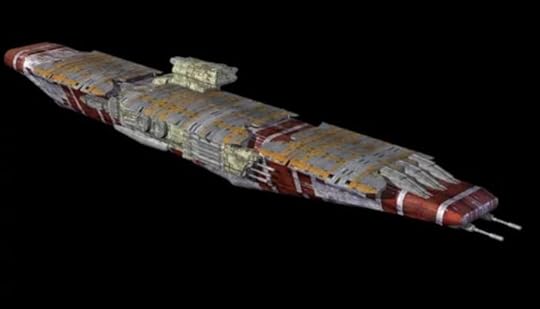
A battleship is the largest warship in any fleet, focused on heavy arms and armament. Battleships can generate their own Gates, and though they aren’t designed to bring additional ships through those Gates the sheer mass of a battleship allows a few Size Class 4 and smaller ships to tuck in tight and fly through in the time it takes the battleship to transition. Battleships are a relatively new development in star fleets, as it is only in the past 50 years a mobile Gate capable of transporting such massive vessel has been developed, and the resulting arms race to create ships able to take on stationary fortifications bankrupted some star nations. At the same time, when fleets with battleships have clashed with fleets of similar tonnage and tech level lacking a BS-class, the strategic need for battleships has been proven again and again.
The key role of battleships is to project force capable of taking out planetary installations, Gate Stations, and major starbases, while surviving the massive attacks such installations can unleash. In fleet maneuvers, battleships are the front-and-center core of offensive formations, anchoring entire fleets and being flanked, supported, and escorted by as many lesser ships as can be spared from other duties. Battleships almost always have a spinal mount weapon, and may have more than one (often with 2 or three facing forward, and 1 or two facing to the aft). It additionally carries multiple batteries of Primaries, with Secondaries or missile tubes emplaced only where space and power allow but a primary could not be made to work. Defensive guns tend to be clustered in tight batteries that give their best coverage to the front arc. Each space navy has its own exact preferred mix of weapons, but any battleship can outgun any smaller ships of any fleet.
A battleship also carries massive armor, powerful shield generators and backup screens, and vast banks of electronic warfare and countermeasure systems, but when a choice must be made between offense and defense, a battleship’s first concern is having more firepower than any other mobile unit. As a battleship is extremely likely to be the flagship of any fleet it is in, they do carry multiple command and control loops and tactical and strategic centers to allow for the operation of the ship by its captain, its fleet by an admiral, and an entire warfront by a war council, and enough diplomatic space to be able to host allies or accept enemy surrenders.
Unsurprisingly battleships are extremely expensive to build, and much more expensive per ton to maintain and operate, than less focused ships. Their narrow focus on the heavy armament needed for system sieges and major fleet engagements makes them no more effective for any other roles than a typical cruiser. Most mid-tier star navies have at most one battleship, often in mothballs, and even top-tier navies rarely have more than 8 total battleships, and no more than 2-3 active at once outside of wartime. Lower-tier star navies simply cannot afford to have modern battleships (though see pocket battleship), and no nongovernmental group can maintain and operate so expensive a vessel.
Fleet Carrier [Size Class A] (FC)
Fleet carriers are the largest warship to regularly see operations outside of wartime, and are on-par with battleships in terms of total tonnage. Rather than spinal mount spinal weapons or Primaries, fleet carriers give up their vast tonnage to carrying squadrons of smaller craft, focusing on non-FTL capable vessels the carrier takes from system to system, though any well-designer carrier also has a number of long-range scout ships, minelayers, recovery and repair craft, missile tenders, and troop transports. Carriers mount some Secondaries, and as many defensive batteries as they can cram onto the surface, but beyond the firepower of their squadrons, most of the punch of a carrier comes from missile batteries backed by their enormous and extremely advanced tracking and targeting sensors and computers.
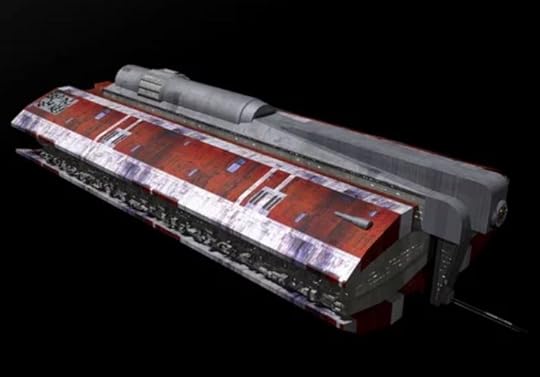
A fleet carrier is too valuable and too vulnerable to ever operate on its own, with the smallest unit to see a carrier being the single carrier group, which normally includes a single carrier, at least one combat vessel (preferably two dreadnaughts, but often just one dreadnaught and a heavy cruiser, two battlecruiers, or even two heavy cruisers), at least two escort ship (often a light cruiser or escort cruiser), one depot ship or tender, and three destroyers (or, if a fleet’s budget and resources are stretched too thin, one destroyer and two pinnaces or cutters). A carrier group is an extremely effective small fleet to deal with a broad range of issues, and can excel at patrol, scouting, escort, antipiracy, system defense, and diplomatic missions where the need to project force in an area needs to be combined with a less militaristic tone than sending a battleship or pocket battleship. Even a carrier group with a dreadnaught is often seen as less threatening than a dreadnaught group by itself, as the need to protect carriers is well-understood, as is the vast flexibility of carriers.
The biggest vulnerability of carriers is that they lack the massive armor and shielding of other warships in their size class, focusing on using their mass on defensive batteries and facilities to store, launch, recover, repair, and support smaller craft. A carrier caught without cover, preferably from both a few squads of active fightercraft and one or more escort ships, is vulnerable to much smaller warships including cruisers, destroyers, and in some cases even frigates.
Dreadnaught [Size Class 1] (DN)
A dreadnaught is a warship much larger than a cruiser, but not as massive as a carrier or battleship. Dreadnaughts have considerable firepower in the form of a single spinal mount weapon or dozens of Primaries (but not both), extremely heavy armor, and densely-packed defensive batteries. Numerous redundant systems, suites of damage control and repair operations, and more internal bracing and bulkheads per ton than any other ship class make dreadnoughts the toughest ships in any fleet, and while they lack the massive anti-planetary-installation power of a battleship, they can actually soak more damage than those larger warships.
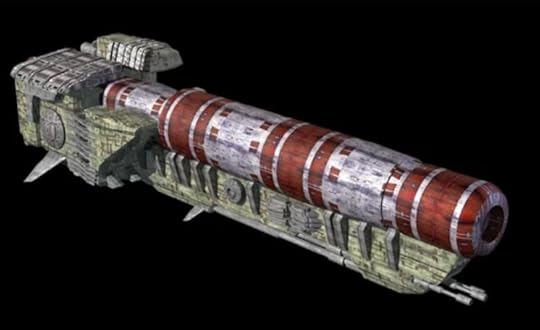
Dreadnaughts primarily serve as the anchor for small fleets not expecting to face space stations or battleships, mobile strongpoints to protect battleships and carriers, and as flagships for space navies unable to afford to build or maintain a battleship (or those so massive as to need numerous flagships and preferring to keep the majority of their battleships mothballed). While dreadnaughts are much more expensive than cruisers, their high durability can make them attractive choices for flagships in situations where the level of risk is not well known. Dreadnaughts often form the core of a carrier’s escort fleet, placing itself between a carrier and the direct line from an enemy fleet. Dreadnaughts can operate independently if needed, but are slower than cruisers and no more effective in nonmilitary matters, and actively worse as pursuit craft.
Missilenaught [Size Class 1] (MN)
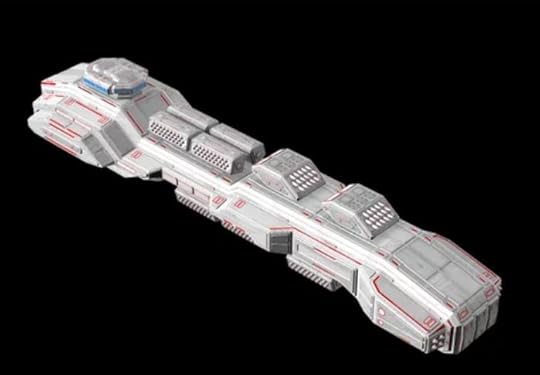
Before the creation of stable mobile Gates able to carrier massive Size Class A ships, the only proven method for taking out major starbases and planetary defenses was to swamp their defenses with a combination of asteroids accelerated by war tug craft and massive missile barrages. The job of carrying and launching those missiles, and surviving counterfire from a station, fell to “missilenaughts,” though very few fleets use that term for their own ships. Rather than focus on a spinal mount, Primaries, or even Secondaries, missilenaughts have as many missile lanchers as they can cram into their outer hull, and as many reloads as they can fit in interior space. This gives them a horrifically powerful throw-weight of offense… briefly. A single missilenaught lacks the firepower to take out a major station by itself, but before size class A ships existed, a section of 4 or 6misssilenaughts was the most efficient way to take out a single enemy base. However, missilenaughts are more fragile than standard dreadnaughts, and must be resupplied after each major engagement. Indeed, a missilenaught often runs out of missiles during a single long engagement, and no one builds them anymore. However, they remain a respectable threat, in some cases have become popular planetary defense ships or carrier escorts, and poorer governments sometimes buy old missilenaughts from richer fleets that no longer need them, representing a “cheap” way to have a Class 1 ship.
Pocket Battleship [Size class 1] (BP)
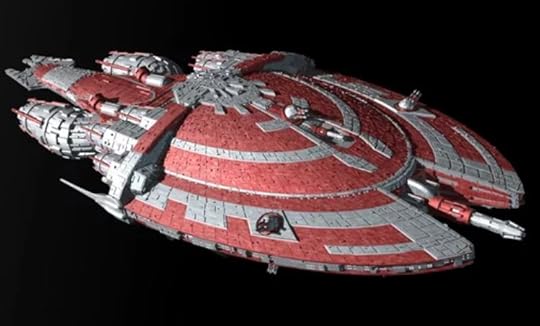
Also often termed pseudo-battleships, battle projectors, and siege vessels, a pocket battleship is an uncommon form of dreadnought designed to fill the battleship role, but on a smaller (and thus less effective) scale. Pocket battleships almost always have twin forward-facing spinal mount weapons, to allow effective firepower to be brought to bear against smaller space stations and planetary installations, and extensive Secondaries and defensive batteries. They pay for this heavy front-facing offense by lacking Primaries and being much less heavily armored than a typical dreadnought—often no more durable than a battlecruiser—and lacking the ability to engage in long-term independent operations. Pocket battleships are mostly only found in the fleets of older mid-tier star navies, or as a single flagship in a lower-tier star navy (though a small number of first-tier star navies do use pocket battleships in large fleet formations, such as an escort to a carrier or backup to a dreadnaught formation). While they are not cost-effective for anything other than assaulting light planetary defenses, having a ship able to project fleet-level offensive power and be more than a match for any cruiser is worth the expense for some star nations that simply lack the means to maintain true battleships, and those that need more offense in their ships of the wall than dreadnoughts provide.
Squadron Carrier [Size Class 1] (SC)

Also called secondary carriers and heavy escort carriers, most squadron carriers are conversions of older missilenaught (or, less often, pocket battleship) hulls built long enough ago that their offensive technologies are out of date and requiring massive overhaul anyway. In many cases, the cost of refitting such ships to match modern DN specifications is prohibitive, but converting them into smaller carriers is relatively cheap (especially compared to the cost of building new, full-size carriers). Although gutting such hulls to install Gate generators able to transport dozens of smaller craft with the main ship inevitably weakens them against heavy enemy fire, carrier tactics don’t call for surviving direct heavy fire. A small number of lower-tier star navies built squadron carriers as new constructions after Gate technology advanced to allow multivessel Gate travel, simply because they could not afford to build Size Class A carriers.
Super-Heavy Frigate [Size Class 1](XF)
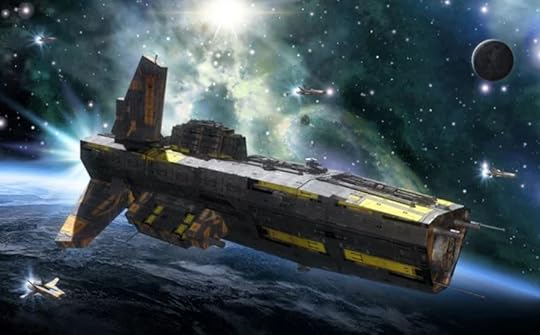
No fleet ever designed and constructed a super-heavy frigate from scratch, but the idea of a ship with the vast endurance and flexibility of a frigate, but on an even larger scale, did appeal to some star navies, especially as Free Gates proliferated and impacted strategic warfare and it became more common for ships to find themselves cut off from supply lines, or stranded when their home bases were destroyed or occupied. A few experimental craft of this type were created by converting other ships, including two famously adapted from capital ships (a dreadnaught and a carrier) that were so badly damaged they had to be refit from the keel-outward. While super-heavy frigates acquitted themselves well, ultimately they were determined to be too expensive to be practical in wartime, and too heavily armed to be needed in peacetime.
Battlecruiser [Size Class 2] (CB)
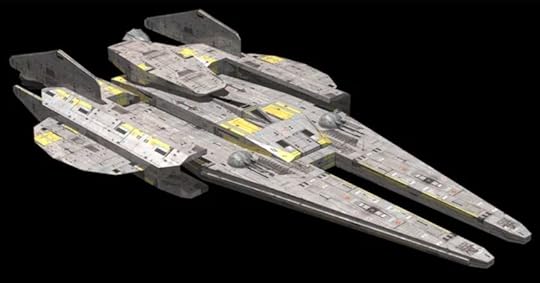
Battlecruisers are built on heavy cruiser frames, but focus on armor and more heavy and defensive weapons, and less on labs and diplomatic facilities. They are often considered “overgunned,” in that the more weapons you cram into their frames, the harder it is so have good armor and sensor coverage. Even so, no pirate wants to see a battlecruiser on their scopes.
Bulk Carrier/Q-ship [Size Class 2] (CB)
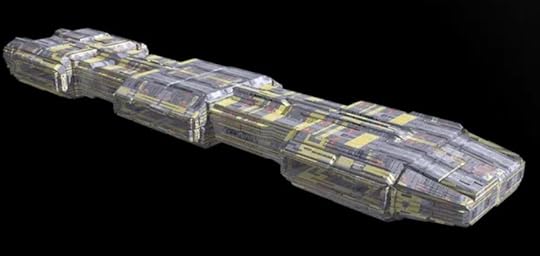
Massive cargo carriers with Free Gates that allow them to take millions of tons of cargo anywhere in the known systems. The risks of interstellar commerce means bulk carriers are always trying to save as much money as possible, so they are commonly traveling from Gate Ford to Gate Ford wherever possible to save on energy costs and generally only travel when full. This makes them appealing targets for pirates, if they pirates can either take out any defensive ships at a Gate Ford (or which there are too many for star fleets to guard *all* of them), especially if it’s a Gate Ford the bulk carrier thinks is a secret. Most civilian spaceship travel occurs in passenger sections of bulk carriers, with accommodations ranging from ships that have a few luxury decks on par with modern cruise ships, to paying for a spot in an empty crew bunk.
Although absolutely not designed for warfare, a bulk carrier can be retrofitted with internal armor bulkheads, massive banks of secondary screens, nearly as many missiles as a missilenaught, lots of defensive weapons, and a few Secondaries. This makes them “eggs with canons,” able to punch in the weight class of a battle cruiser (albeit wth less range), but more fragile than even a light cruiser. However, such ships (called “Q-Ships”) are sometimes used to hunt pirates, as they can retain their nonmilitary freighter appearance.
Smaller cargo ships also exist, of course, but economic realities generally makes them either non-Gate capable single-system shipping, or more like smugglers or special curriers than normal commerce vessels.
Command Cruiser [Size Class 2] (CC)
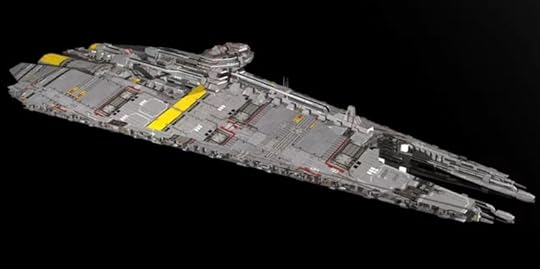
A command cruiser is essentially a heavy cruiser with the most modern sensors and labs possible, extra space added for a commodore or rear admiral to run a small fleet or a wing of a larger fleet, and diplomatic quarters. On paper they aren’t more effective in combat than heavy cruisers, but a combination of getting elite crews and being able to handle more unexpected situations often gives them an unexpected edge. They are a great deal more expensive per ton to build (though not to maintain), and low-tier fleets often don’t bother with them, or have one or two as flagships.
Destroyer Tender [Size Class 2] (DT)
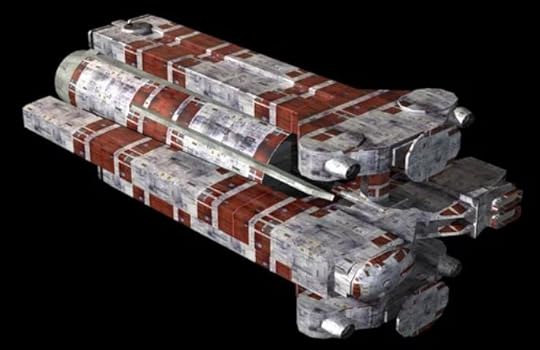
A destroyer tender is a noncombat ship designed specifically to provide support to a group of 3-7 destroyers. The tender has extensive resupply and cargo capacity, and the necessary parts, machine shops, and facilities to maintain a destroyer for long periods of time. While ideally a destroyer tender is custom-built to fulfill this role, in reality, tenders converted from bulk cargo haulers, mobile mining platforms, and salvage ships are far more common. Multiple destroyer tenders could also function as tender for a larger fleet.
Heavy Cruiser [Size Class 2] (CA)
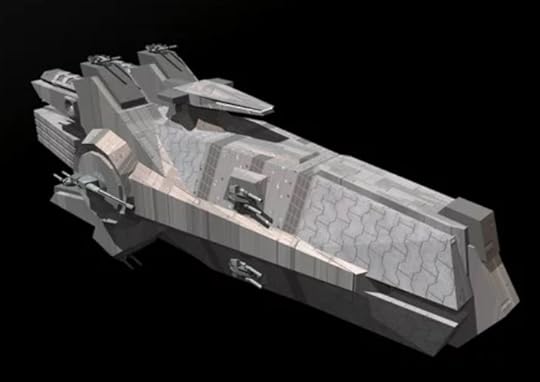
The workhorse of most star navies, the heavy cruiser is the modern incarnation of the pre-Free-Gate Armored Cruiser, which was designed to survive being sent through a system Gate and finding hostiles at the other end of its travel. Most mount a mix of a small number of Primaries, Secondaries, missiles, defensive weapons, sensors, interior carrier craft, labs, medical facilities, and diplomatic facilities, but they do not specialize in any of those roles. A heavy cruiser is designed to be a generalist, sacrificing being the best ship for any role by being an adequate ship for every roll.
Heavy Frigate [Size Class 2] (HF)
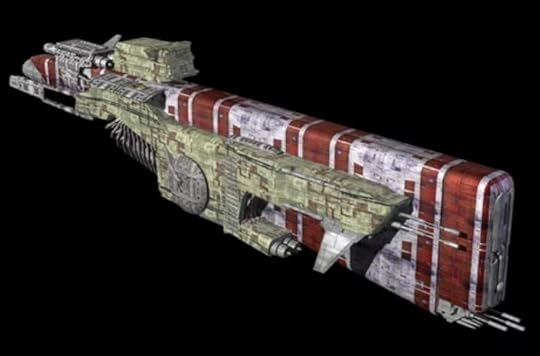
Heavy frigates were designed to be the next generation of free Gate ships, able to explore, scout, sit on-station, and even build and support an entire new colony from scratch. The size of later battle cruisers, heavy frigates had at-best a light cruiser’s armament, combined with extensive support systems and cargo capacity matched only by deep-space explorers or small stationary starbases. The improvement in free Gates, and the increasing number of shipyards able to build them, made the heavy frigate obsolete for its main function shortly after the first units became active, and most fleets have stopped building them.
The one combat advantage of a heavy frigate was its ability to survive damage – though no more armored than a true battle cruiser, a heavy frigate’s extensive secondary systems were generally built in a shell around its crucial components. While losing machine shops, vehicle hangers, cargo bays, conference rooms, theaters, and redundant secondary and tertiary systems reduced a heavy frigate’s flexibility and endurance, it didn’t reduce its overall combat effectiveness. Nothing smaller than a dreadnaught could survive as much damage as a heavy frigate.
Monitor [Size Class 2] (BM)
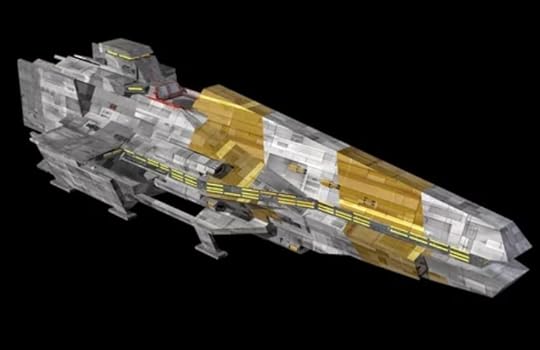
Monitors were originally constructed as system defense ships; heavily armed and armored vessels that lacked any significant noncombat functionality and had extremely limited operational endurance. While some ships of that type still exist, the main “monitor” of the modern era is a ship that combines the offense of a battlecruiser, and extended facilities of a command cruiser, and has greater armor than either, in exchange for not having a free Gate. They are only common in areas with a Gate Station, and fleets that can afford to build ships they never plan to deploy beyond those systems. A few Monitors can be found in orbit around old Gate Fords, having been sent to some battle by a Gate Station in desperate times, and having no way to go home. Generally still resupplied by their home fleets, they become de factor minor mobile stations at those Gate Fords.
Armored Frigate [Size Class 3] (AF)
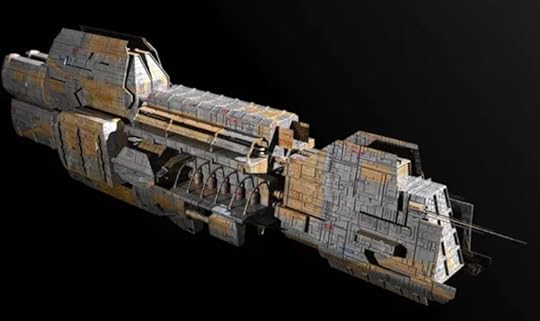
When old Free Gate ships were upgraded with modern engines and gate systems, they often ended up being able to haul much larger mass loads. While rebuilding their interior systems to add new weapons or secure cargo storage was too time-consuming to be practical, it was often possible to simply weld additional armor plates on over key points on the ship. The amount of benefit gained from this armor upgrade varied by design, but armored frigates gained a reputation for being able to absorb damage well out of proportion to their size.
Light Command Cruiser [Size Class 3] (CLC)
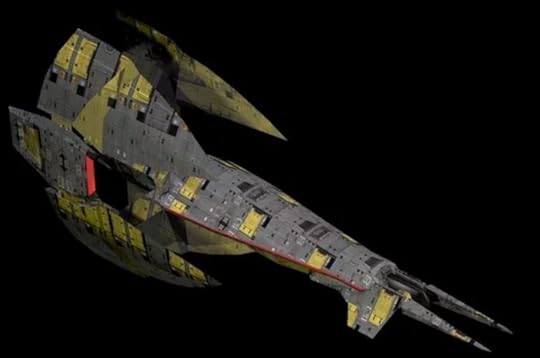
A light cruiser that sacrifices some breadth of utility for additional sensors, communication, and command facilities. Mostly only used by low-tier fleets who cannot afford command cruisers or bigger ships, often as flotilla leaders.
Light Cruiser [Size Class 3] (CL)
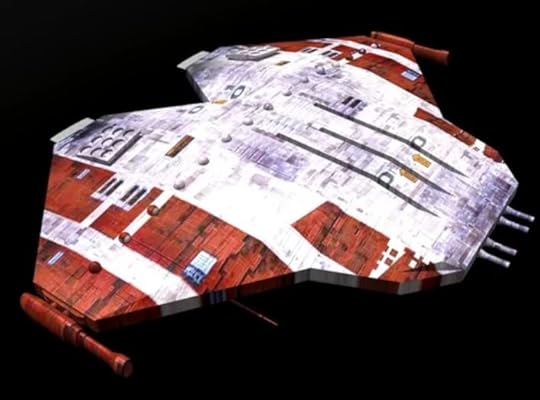
A heavy cruiser’s concept, but one size smaller. Rather than being “adequate” for any task, it’s adequate for common roles, and “better than nothing” for anything else. However, light cruisers are a good deal cheaper that heavy cruisers to build and maintain, and many fleets prefer having 5 light cruisers over 3 heavy cruisers.
Escort Cruiser [Size Class 3] (EC)
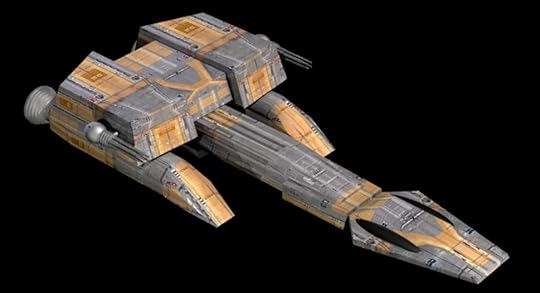
An escort cruiser is an uncommon class of ship designed exclusively to act as an escort for larger, more powerful starships such as carriers, dreadnaughts, and battleships. Most star navies lack the resources to have a class of dedicated cruisers this size, depending on destroyers, frigates, and even brigantines for such roles. Escort cruisers generally have no Primaries and only a small number of Secondaries, but are well-armed with defensive batteries covering all arcs, as well as extensive sensor arrays. Escort cruisers also have far more noncombat resources, and are designed to be able to pair with a larger ship to allow it to operate without a full support fleet, though normally anything important enough to have an escort cruiser assigned to it is important enough to have at least a few more smaller ships as well.
Escort Carrier [Size Class 3] (CE)
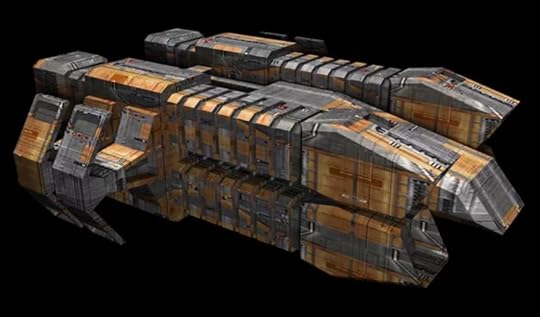
Escort carriers exist primarily to shuttle new fighters and supplies to larger carriers, though they can also serve as additional fighter and missile capacity for small units lacking larger carriers, such as a cruiser or frigate patrol group. However, escort cruisers lack the armor to get anywhere near direct ship-to-ship combat. Escort carriers are often converted hulls from depot ships, tenders, and civilian craft.
Depot Ship/Field Tender [Size Class 3] (PT)
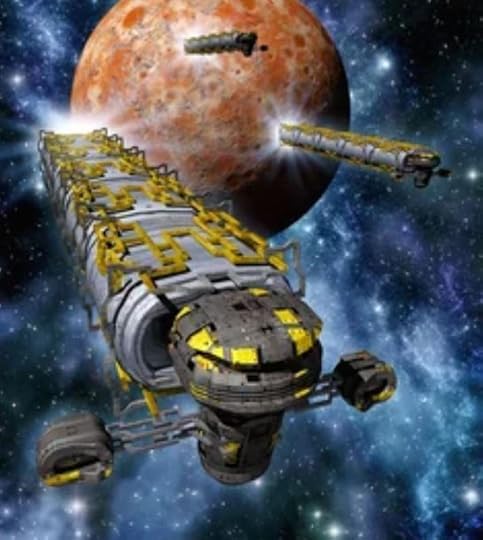
Depot ships are military transports, designed to have the armor to survive being targeted by enemy raids, and the cargo capacity to bring resupply to much bigger ships. They lack any Primaries or Secondaries, and have just enough defensive weapons and missile lanchers to keep pirates at bay. A ship that makes runs to and from locations is generally a “depot ship,” while one that travels with a fleet to resupply as needed is a field tender.
Frigate [Size Class 3] (FF)
A frigate is a ship smaller than a cruiser, but able to operate independently for long periods of time. Frigates don’t generally have Primaries, with Secondaries being their heaviest armament, but may have a great deal more defensive weapons and a decent bank of missiles. They are also designed to operate independently for long periods of time, and are often scouts, flank guards, exploration vessels, and the largest ship the richest and most powerful non-government groups can afford to build or maintain.
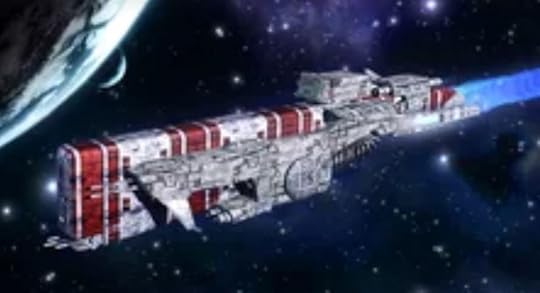
Early in the Gate Wars, it was determined that the ability of frigates to travel through self-generated Free Gates made them excellent scouts, raiders, and picket ships. Frigates were able to operate independently for long periods of time, allowing them to both strike deep into enemy territory, and sit on-station in defensive positions for long periods.
The original ships of this class were the largest vessels the first generation of Free Gates could move, and so these ships were build for mobile military operations and exploration. It was perhaps inevitable that the first starships able to generate their own warp gates, known as “Free Gate” ships, would come to be referred to as frigates. Since that function can now be filled by larger vessels, many modern frigates serve specialized functions, such as medical frigates (FFM), repair frigates (FFR), minelayer frigates (FFL), and diplomatic service frigates (FFD).
Patrol Carrier [Size Class 3] (CP)
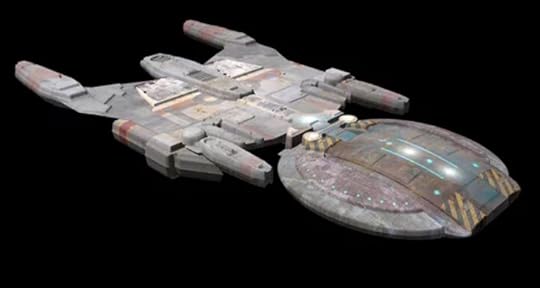
A patrol carrier is a warship roughly the size of a destroyer or frigate, that serves as a very small but self-reliant fighter carrier. These are most often used by high-tier navies as patrol craft for Gate Fords, allowing them to cover a large volume of space with numerous non-FTL craft the carrier can support and transport as needed. They can double as escorts for larger craft that lack enough hangar capacity for fleet operations.
Destroyer [Size Class 3] (DD) – Once the Gate Wars were in full swing, analysis revealed frigates which had not been designed primarily for combat missions, and simply too expensive and resource-intensive to build in large numbers to fill out fleets once all sides moved to wartime production priorities.
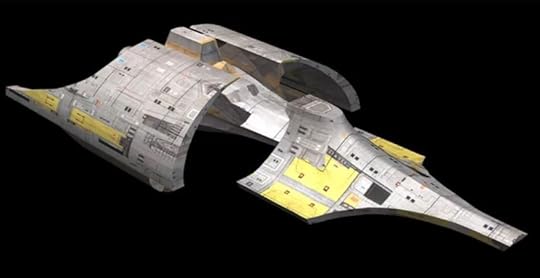
Instead, significantly smaller, much leaner ships initially conceived of as “Frigate-Destroyers” were designed. Frigate-destroyers could perform many of the wartime functions of a frigate, though with less self-sufficiency and shorter operating times. They lacked many of the capabilities that made frigates so flexible; such as small craft bays, landing craft for companies of marines, extended sensor arrays, deep storage and reloads, creature comforts for their crews, full self-repair systems, and facilities for diplomatic missions, disaster relief, and spare cargo capacity, but had just as much armor and first-strike armament as the vessel they were designed to counter. By stripping down to the bare military minimum, it was possible to build and crew two frigate-destroyers for the time and cost it would have taken to create a new frigate.
Frigate-destroyers proved extremely effective in their roles, and soon variants began to be built to perform specific missions. The term “destroyer” came to encompass a broad class of small long-endurance combat-focused starships. Destroyer escorts focused on defensive systems to help protect larger and more expensive starships, destroyer scouts had upgraded sensor systems, assault destroyers had higher first-salvo throw weights, and
Corvette [Size Class 4] (CV)
A corvette is the smallest vessel able to mount military-grade weapons, shields, and armor and power them at the same time as a mobile Gate. They are often used for reconnaissance, patrol duties, and interdiction operations. Corvettes are fast and maneuverable, allowing them to swiftly navigate through space and engage smaller targets. They usually carry point defense weapons and light missile systems.
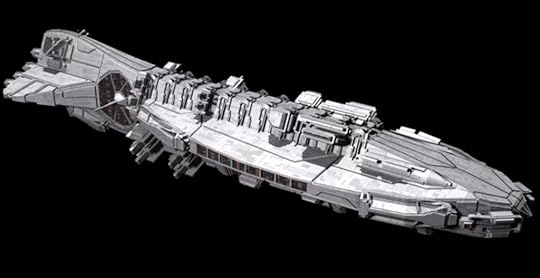
There also exist Slow Corvettes, which have slightly more weapons and secondary systems in return for not being able to power their Gate at the same time as other major systems. It takes weeks for a Slow Corvette to make a Gate jump anywhere, but that’s significantly better than being stuck somewhere forever. Slow Corvettes are popular escort ships in mid- and low-tier navies, designed to be carried by the Gate of the larger ship it’s escorting under normal circumstances, but able to travel solo in an emergency.
Brigantine [Size Class 4] (BG)
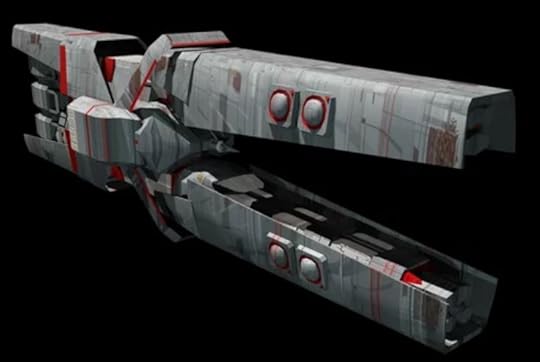
A brigantine is essentially a corvette that sacrifices having its own Gate for more weapons, armor, and secondary systems. They are common police and local defense vessels in relatively safe systems, and few can sometimes be carrier by the largest fleet carriers.
Pinnace [Size Class 5] (PN)
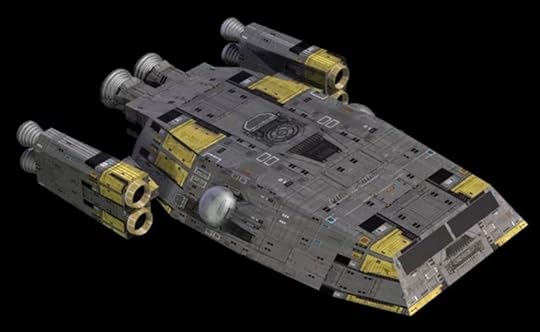
A pinnace is the smallest class of ship that can mount its own free Gate, and it can’t also fit in military-grade weapons. A pinnace can carry minor defensive weapons, and may be able to damage a pirate ship converted from a cargo ship or scout, but aren’t a match in a fight with any true military starship. They are often used as long-range transport ships carried by much larger ships, and as the private starships of the mega-rich.
Gunboat [Size Class 5] (GN)
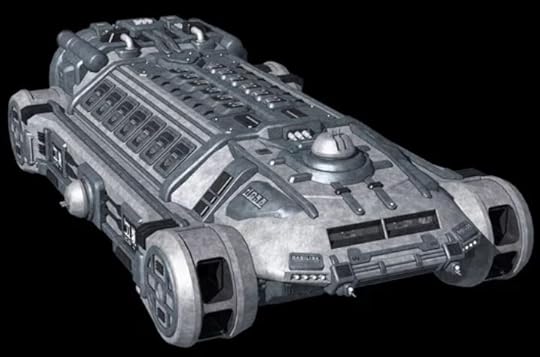
A gunboat is the smallest class of ship that can mount its own military-grade weapons (sometimes a single Secondary, usually just a few missiles and defensive weapons), but it can’t also fit in a free Gate. They are often squad leaders for attack craft in carriers and stations.
Cancer Support
I have cancer, and am on chemo (and likely will be for months to come). If you want to help me cover cancer treatment costs, right now, one great way to offer your support is to pick up The Traveler’s Guide to the Darklands: For Pathfinder 2E, which a vast number of amazingly talented people put together as a charity product to aid me. And it’s got excepts from Alphonse Lord Tabbington! Also, the product Like A Boss – A Book of Boss Encounters is a community project put together by Samurai Sheepdog to help me cover costs.
Or, if you prefer, I do accept donations to my Ko-Fi, which doesn’t take a cut before passing the money on to me. (Also, there are cat pics there!)
And, of course, a big part of my income comes from people supporting my Patreon, so joining that is a big help!
November 29, 2023
Health Update: Battle Fatigue
I have cancer. I’ve been on chemo for more than 6 months. Chemo is a stopgap, until I meet conditions for surgery to remove the tumors.
You can get more details about all that starting here.
For roleplayers, I appear to be in the part of the campaign where I know who the bad guy is, but there’s absolutely nothing I can do about it. All research fails, all leads fail to pan out, and no civilians appear to have the sense of urgency the situation calls for. It sucks in a game, and it sucks in real life.
I have a prescription my colorectal surgeon, oncologist, GP, and urologist all want me to take. It’s $1600 a month, the pharmacy doesn’t have any and doesn’t know when they will (and neither does any other pharmacy I’ve called), and my insurance won’t tell me if its covered until I try to check out with some in my hand. If insurance does cover it, it’ll likely be “only” $320 a month. I’m likely to be on the car-payment-costing-at-best drug for years, and maybe the rest of my life… if I can ever get any at any cost.
This, by the way, is where a GOOD roleplaying game would reveal the location of a dragon sitting on a hoard of RX. We could get a team together, try a heist, have it go terribly wrong, and kill it in a spectacular battle with iffy CGI effects. Or at least see if the dragon takes my insurance.
Also, I have one set of doctors I got a referral for in March wouldn’t even send me an intake until May, which required me attend a seminar in July, which I did but they failed to send me a follow-up within 2 weeks and I wanted 3 to call them, so “their procedure” (which no one, including their facility administrator was willing to consider altering, even though I have cancer and am on a clock) was to require me to take the SAME seminar again and the next one was in… September. So I did, and got their intake form this time, and sent it back, and was told I’d head from them in 2 weeks. At 2 weeks and I day I called noting I had not heard back, and didn’t want to be stuck at the beginning of their procedure again. Instead I was told they were trying to decide to take me on as a patient at all, since I have cancer.
Which was WHY I had a referral to them, and they knew in May. The most annoying thing here is I can never complain about a fictional administration being unrealistically incompetent again. This SHOULD lead to a Shadowrun or Cyberpunk game, where we hack their system and add me to their list. Hell, I’d play it in TORG if I could cut some red tape that way.
But, instead, I get to deal with the additional complication that my insurance won’t cover their services, which run about $32,000. It’s clear that when they told me that, they expected me to dejectedly say “Oh… nevermind then. Sorry for wasting your time'” so they had just stopped worrying about it. Instead I informed the drone on the phone I’d cover it out of pocket (medical credit card, here I come), which left them sputtering and saying they’d get back to me in a week about if they were willing to take me.
That was mid October. I’ve spoken to someone there every week since then. No decision yet, but each time they expected it’s just be another week. It’s a freaking Pythonesque farce. ‘This is customer service.’ ‘No it isn’t.’ ‘Yes, it is.’ ‘No. It isn’t. ‘Ah-ha but yes, it is.’

(“Now you must bring us… a shrubbery!” Art by Berdsigns)
Meanwhile, the Tumor Board was beginning to consider changing the circumstances under which to operate on me, since they can’t get these other drugs and doctors to help, either. Which is higher-risk, more expensive, and has a higher likelihood of an “undesirable outcome” (I guess saying “it could be an ugly TPK!” doesn’t sound good in a doctor’s office). So, how is that going?
Last Wednesday, they told me they’d know by today. I called, and they don’t know yet. They realized I had an MRI next week, and decided to wait to see the results of that. But since I have it after next week’s tumor board meeting, the earliest they can make a decision is in 2 weeks.
And this keeps happening. A few days becomes a few weeks becomes one more test, one more drug no one has, one more insurance denial I have to navigate. My oncologist is slowly growing concerned with how long I have been on chemo, especially when there is currently no end in sight. My colorectal surgeon is talking about performing surgery in higher-risk conditions because we’re not having any luck lowering those risks. The current “best plan” literally involves scooping some of my fat out through liposuction to make an alcove in my flesh they can both use to access my guts, and if needed (which is likely) house a permanent ostomy bag connection.
I’ll literally be mutilated in shape, so I can survive. Mutilated by liposuction which, I’ll note, I have repeatedly been told I can’t have for any purpose whatsoever, no matter the quality of life gain a tiny amount in the right place could give me.
So, I wait. Maybe I get the drug, maybe I don’t. Maybe it’s $1600, maybe it’s $320… so $19,200 or $3,840 for a year. Maybe I get in with the doctors who have strung me along since May, maybe I don’t. Maybe 2 more weeks of chemo, maybe another 6 months. Maybe I have Ikea shelves carved intoo my flesh for the convenience of medical tools, maybe not.
Maybe I’ll know in 2 weeks. Maybe I won’t. But what seems certain at this point is that nothing will actually be DONE until January… when my insurance’s annual deductibles will reset for the second time in 6 months.
Oh, and I need to arrange for next year’s health insurance. Time to roll on the Random Wandering Monstrous Complication table.
Back in February, in the hospital, I knew I had an unlimited amount of fight in me to overcome this. Now, I see that’s not true.
Support
This *all* takes money, bills are mounting, and my resources (of energy and money) are running thin. You can donate to my ko-fi, if you want to help. There are cat pics there, too.
November 28, 2023
Eldritch Blood Powers for Bloodragers in 1st Edition Pathfinder
The blood stirs, and burns within me. In this, I understand what the sorcerers feel. But they speak of their blood whispering, murmuring lost secrets to them. My blood does not whisper. It screams. It storms, it demands I raises my fist to the world and bellow forth our joint challenge. My blood is not quiet, but in it’s ragged voice, I can hear power.
–Eirgen Redwulf, Bloodrager

(Art by warmtail)
The idea of a wild, raging character infused with ancient magic powers from a potent heritage is a popular and fun concept in ttRPGs. In the 1st edition Pathfinder Roleplaying Game, this concept is often represented by the bloodrager, a hybrid barbarian/sorcerer with a deadly fury, eldritch powwrs and, eventually and limitedly, spellcasting power. But taking time and focus to cast spells, even violent battle-spells, doesn’t always match the
Eldritch blood is an alternative to spells for bloodragers in the 1st edition Pathfinder Roleplaying Game. At 4th level, when a bloodrager normally gains access to spells, they can instead select one of the eldritch blood options listed below. The bloodrager gains no spells known, spells per day, or caster level. Once this decision is made, it cannot be changed. Each eldritch blood option increases in power at the same levels a bloodrager would normally gain access to casting a new spell level of spells (7th, 10th, 13th).
Eldritch Blood
Additional Heritage: In addition to the full powers of your bloodrager bloodline, you gain some abilities from a second bloodline. Select a bloodline other than the one you selected as a 1t level bloodrager. At 4th level, you gain the 1st level power of this additional bloodline. At 7th level you gain its 4th level power, at 10th level you gain its 8th level power, and at 13th level you gain its 12th level power. You do not gain any other benefits of your selected additional heritage.
Battle Blood: At 4th level when in a bloodrage all your attacks are treated as magic for purposes of bypassing DR. At 7th level, they are also treated as cold iron and silver. At 10th level, they are also treated as chaotic. At 13th level, they are also treated as adamantine.
Blood of the Sea (Su): The magic in your blood years for the water. At 4th level when you are in a bloodrage you gain a 20 foot swim speed and can breath underwater. At 7th level, you gain these benefits even when not in a bloodrage. At 10th level, your swim speed increases to 40 feet. At 13th level, your swim speed increases to 60 feet.
Blood of the Sky (Su): The magic in your blood years for the sky. At 4th level when you are in a bloodrage you fall slowly unless you choose to do otherwise, as if under the effects of a feather fall spell. At 7th level, when in a bloodrage you can gain and lose altitude as if under the effects of a levitate spell. At 10th level, when in a bloodrage you gain a 20 foot fly speed with average maneuverability. At 13th level, when in a bloodrage you gain a 40 foot fly speed with perfect maneuverability.
Healing Blood (Su): The eldritch power within your blood has healing power. At 4th level when you are in a bloodrage, you gain fast healing 1. This increases to fast healing 2 at 7th level, fast healing 3 at 10th level, and fast healing 4 at 13th level.
Knacks: Your bloodline lends itself to picking up specific tricks and tactics. You gain additional bonus feats at 4th, 7th, 10th, and 13th level. These must be combat feats, or bonus feats from your bloodline. If you have taken all the bonus feats from your bloodline, you can use your bloodline feats gained at 6th level and every 3 levels thereafter to gain combat feats. You must meet all the prerequisites of the feats gained through your knacks.
Steady Blood: When the power of your blood is awoken, it brings with it mystic surety and confidence. At 4th level, select one of the following skills: Acrobatics, Climb, Escape Artist, Fly, Ride, Stealth, or Swim. When you are in a bloodrage, you can take 10 with the selected skill, even when distractions or stress would normally prevent you from doing so. You select a second skill you can use this ability with at 7th level, a third at 10th level, and a fourth at 13th level.
Cancer Support
I have cancer, and am on chemo (and likely will be for months to come). If you want to help me cover cancer treatment costs, right now, one great way to offer your support is to pick up The Traveler’s Guide to the Darklands: For Pathfinder 2E, which a vast number of amazingly talented people put together as a charity product to aid me. And it’s got excepts from Alphonse Lord Tabbington! Also, the product Like A Boss – A Book of Boss Encounters is a community project put together by Samurai Sheepdog to help me cover costs.
Or, if you prefer, I do accept donations to my Ko-Fi, which doesn’t take a cut before passing the money on to me. (Also, there are cat pics there!)
And, of course, a big part of my income comes from people supporting my Patreon, so joining that is a big help!
November 23, 2023
The Green Bean Casserole Monster
So, on this National Day of Mourning/National Family Health History Day/Turkey Day/Wolfenoot, I want to express how much I appreciate my family, friends, and fans who read my stuff, follow my social media feeds, support my patreon, and donate to my ko-fi.
Seriously, all, thanks. To say this has been a “rough year” would be a massive understatement. But it is in this darkness I have found the brightest lights. I am eternally thankful for all the people who have expended so much time, emotional energy, and yes, money, to keeping me upbeat and, well, alive.
So, since it’s a day of holidays, I am going to celebrate with a classic Silly Monster — a Green Bean Casserole Talos!
(A “talos” is a form of self-aware construct, a statue or figuring of normally-inanimate matter animted through magic, often created by spellcasters as a servant or guardian. Making inanimate matter self-aware is a tricky process, one normally reserved for entities such as gods and eternals. Doing so requires complex (and generally expensive) ceremonies… but sometimes those happen on accident! And, sometimes, a talos goes rogue…
Green Bean Casserole Talos

(Art by the amazing Stan!)
Lore: Green bean casserole taloses normally come into being one of two ways, The first is as a form a trap, left sitting in a ceramic crock or similar dish with commands to attack first the creature that opens it’s home, and secondly everything else it sees. This is most commonly used by evil alchemist chefs (alchefists) as a form of ambush at feasts, celebrations, and buffet restaurants.
“The cook sends his… regards!”
The second common origin for a green bean casserole talos is when a warlock cook (a warcook) attempts to make a fancy enchanted dinner and things go horribly, beanily wrong. This is usually a result of placing the green bean casserole at the center of the magic oven while trying to enchant multiple mystic food dishes at once, and having to use not quite the right temperature, cooking time, or amount of fairy dust. This type of food talos generally seems entirely normal and edible, until someone sticks a serving spoon in it, and then all bets are off!
Building the Monster: You can turn nearly any creature with melee attacks into a Green bean Casserole talos by adding the following properties. These are designed to work with a range of d20-evolved game systems, so they may not match the exact format of your monster stat block of choice. If something seems a tad off, just adjust to the closest-sounding thing in your own game system.
This article assumes a green bean casserole talos is about human sized and roughly humanoid, but that’s not mandatory. A green bean dragon talos or casserole slime can perfectly well work too.

(More Stan! art, and he also gave some lovely feedback on early notes for this critter)
Crunchy: The fried onion topper of a green bean casserole talos is invitingly crunchy. Magically so. The first time a creature is adjacent to a green bean casserole, it must make a Will/Wisdom save (of typical difficulty for abilities from a monster with the casserole’s CR/Level/HD). On a failed save, the creature must take at least one action per round to attempt to bite the casserole. Treat this as a unarmed attack that deals lethal damage (I mean, you’re biting a casserole). Once a creature successfully takes a chomp, the effect ends. But, also, see “Hot.”
Hot: Creatures that bite a green bean casserole talos burn their mouths. A successful bite attack results in taking fire damage equal to the talos’s main melee attack.
Gooey: The main mass of a green bean casserole talos is semi-congealed beans bound by gravylike mushroom soup mix. The material manages to be thick, heavy, and easily reshaped without losing any of its core consistency. As a result, the holiday monster normally takes only half damage from bludgeoning, piercing, and slashing attacks. However, the talos is not as resilient when frozen or put in foil. While it is entangled, or for 1 round after it takes cold damage, the green bean casserole talos loses its gooey spcial ability.
Savory: A popular food combination full of umami, the internal scent of green bean casserole can inspire the fit, and weaken the hungry. This effect is magnified for the magically-infused cuts of a green bean casserole talos. Creatures adjacent to a green bean casserole talos when it is injured have one of the two following effects. If fatigued or exhausted, they take a -2 penalty to all d20 rolls until that condition ends, or they take a bit of the casserole (or a similarly hot, delicious food, at the GM’s discretion). If NOT fatigued or exhausted, creatures adjacent to the green bean casserole talos gain a +2 morale-based bonus to all d20 rolls, as the smell is so encouraging.
Splattery: The green bean casserole talso can splattery if not treated gently. When damaged, it splatters. This targets one creature within 30 feet with a touch-based ranged attack. The attack roll is equal to the casserole’s main melee attack, but it does only half the normal amount of damage.
Talos: The green bean casserole talos has all the traits of constructs. It does not need to eat, sleep, or breathe. If an effect only works against a specific subtye of constructs, it works against a talos.
A green bean casserole talos always seeks to carry out the commands it was given when created. In addition, it seeks to protect the crockery it was first animated from, and attacks anyone who damages or threatens it.
That’s it! Simple, right? HAPPY HOLIDAYS, Y’ALL!
Support
Anyone who wants to offer me some extra support can always donate at my ko-fi, with my deepest gratitude.
November 21, 2023
Top Ten Geeky Stories Whose Time Has Come
I haven’t done one of these in a while, and the Zeitgeek is an ever-shifting ether of popularity, burnout, excitement, and eye-rolling that calls for revised Top Ten lists of mashups and elevator pitches. So, here are the Top Ten ideas for series or movies designed to capture tomorrow’s geek viewing dollar!
10. The Vampire – Yep, my first entry is a link to my pitch for a Universal Monster’s shared universe pitch, building off 199’s The Mummy. It’s shameless self-promotion… which is *very* 2023.
09. Cloverfield/Godzilla/Gamera/Pacific Rim: “World War Kaiju” – I don’t care if it makes sense or not. If we can have Monarch and Godzilla Minus One at the same time, we can multiverse kaiju stories to our heart’s content.
08. The Last of Us: Gotham – So, what is riding out the fungapocalypse like in a city already filled with crazy? Do it as an animated Elseworlds movie, kill Batman and the Joker both in the first 5 minutes, and let the second-stringers fight it out. Oracle and the Riddler team up. Ivy wants to make the whole thing worse. Robin becomes exclusively carnivorous. Harley just hits things with a bat. Hilarity ensues.
07. Money Heist: Squid Game – Yep, those loveable thieves set their sites on the gambling money of the deadly Squid Games. Netflix would make a mint. Then cancel it after 2 seasons. Which, honestly, might be for the best.
06. Dungeons & Dragons Cartoon Live Action: Maybe we get another D&D movie. Maybe we don’t. But the characters from the cartoon remain popular, and a live-action version of their exploits as adults would be worth at least one season on Hulu.
05. Invincible Zombies: Both DC and Marvel have done “zombies” stories set in their superhero universes, so it’s a proven concept. And for goodness sake, if anyone could come up with some cool zombie stories for supers, it’s Robert “Walking Dead” Kirkman… who happens to have written the Invincible comic! It’s a perfect match.
04. CSI: Metropolis – Yep, I’ve pitched this before. but set it in the universe of Patterson’s “The Batman,” as a spinoff/season two of the Penguin TV show? It’s a really natural fit.
03. The Pugsly Files – So what IS Wednesday’s little brother doing while she’s off at the Nevermore Academy? Well, I’d argue he should be doing, you know, “Stranger Things” with his own set of younger oddballs and outcasts.
02: The Starfinder Movie – There are several movie companies that could use a big scifi franchise. RPG media is growing in popularity. Starfinder is already popular, well-thought-out, and brimming with potential connected plots. And, based on the historic record, Paizo is MUCH less likely to have a huge PR shitstorm right before a movie based on their IP comes out.
01: DC Vs. Marvel Movies: – Look, DC movies are rebooting. Marvel may reboot soon. Neither is currently catching the wave of excitement Marvel got ramping up from Iron Man to Avengers: Endgame. So, what could moviemakers put on the screen that would have that same fanshock and excitement?
At the end of the next Doctor Strange movie, Doctor Fate walks into the Sanctum.
Or Alias: The Spider shows up in the Spiderverse. Wonder Woman runs into Marvel’s Thor among the gods. The Green Lantern Corp seeks out Captain Marvel. Fury learns about a multidimensions threat, picks up a red phone and calls Amanda Waller. The point is, you end a movie with a stinger suggesting the Big Two are combining forces for a multimovie plotline?
You get butts in seats opening day of the next film. AND you still have Amalgam to go to after running this combo into the ground.
Patreon
I have a Patreon. It helps me carve out the time needed to create these blog posts, and is a great way to let me know what kind of content you enjoy. If you’d like to see more Movie Pitches, or Pathfidner 1st edition, Starfinder, or ShadowFinder content (or more rules for other game systems, fiction, game industry essays, game design articles, worldbuilding tips, whatever!), try joining for just a few bucks and month and letting me know!
If you prefer, you can drop a cup of support in my Ko-Fi. It’s like buying me a cup of coffee, but more convenient!
November 17, 2023
New Name and Class Feature for the Pellar, a Spellcasting Class for Pathfinder 1st edition.
So, first, let’s talk about a big change. For weeks I’ve been working on a ‘thaumaturge’ class for 1st edition Pathfinder. As of this post, I’ve renamed it the ‘pellar,’ a term for a dispeller or cursebreaker (‘expeller’) from Cornwall (where I have ancestry).
The reasons for this are twofold. The first is that it’s a closer match to my core concept than thaumaturge, and gives a nice through-line I can explore in a second draft. (For example, I should look into adding more counterspell-related feats to the list of bonus feats to be selected.) Second, there’s a “thaumaturge’ class for 2nd edition Pathfinder that isn’t at all like my PF1 class, and it invites confusion to introduce a different concept of class with the same name.
Also, since we’ve changed the class name to “pellar,” we obviously don’t want them to gain a “thaumaturgy pool” anymore. Instead, we change that ability to “spellwork” (in keeping with the spell expertise theme), and grant the class a ‘spellwork reservoir’ of points. The newly-named class feature works the same way, just the name changes. These changes have been retroactively applied to the articles on this blog.
Now, with that out of the way, let’s do some NEW content. There are still gaps in the pellar’s level progression where nothing really fun and interesting happens. When looking for something to fill those with, it immediately becomes clear the pellar lacks a set of selectable class features in the vein of rogue talents and oracle revelations. Those two things seem like a perfect match for each other, so let’s slap some “Pellar Edges” into the open slots, write up some cool on-theme powers, and see what a final first draft of the class looks like. (Backers of my Patreon have access to a compiled and revised pellar class that brings all these articles together.)
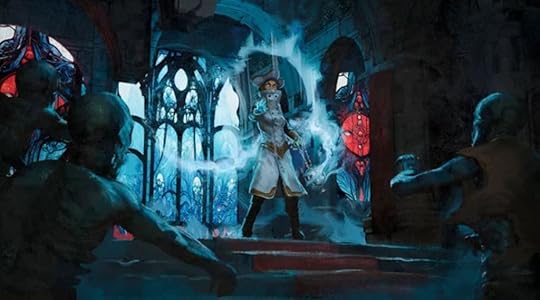
(Art by Dominick)
ClassBaseFortRefWillSpellsPerDayLevelAttackBonusSaveSaveSaveSpecial1st2nd3rd4th5th6th1st+0+2+0+2Pellar edge, spellwork (counterspell, spell known)1–––––2nd+1+3+0+3Bonus feats2–––––3rd+1+3+1+3Spellwork (Silent & Still)3–––––4th+2+4+1+4Pellar edge31––––5th+2+4+1+4Bonus Feats42––––6th+3+5+2+5Spellwork (arcane spell)43––––7th+3+5+2+5Pellar edge431–––8th+4+6+2+6Bonus feats442–––9th+4+6+3+6Spellwork (heighten spell)543–––10th+5+7+3+7Pellar edge5431––11th+5+7+3+7Bonus feats5442––12th+6/+1+8+4+8Spellwork (staves and wands)5543––13th+6/+1+8+4+8Pellar edge55431–14th+7/+2+9+4+9Bonus feats55442–15th+7/+2+9+5+9Spellwork (limited wish)55543–16th+8/+3+10+5+10Pellar edge55543117th+8/+3+10+5+10Bonus feats55544218th+9/+4+11+6+11Spellwork (wish)55554319th+9/+4+11+6+11Pellar edge55555420th+10/+5+12+6+12Bonus feats, spellwork (supernatural)555555(Pellar skills and proficiencies are found here)
CLASS FEATURES
Pellar Edge: At 1st level, and every 3 levels thereafter (4th, 7th, 10th, and so on), a pellar’s insight and research into how spells works grants them an edge in a specific area of magic. Some pellar edge’s have a minimum class level, listed with the ability’s name. You cannot select the same pellar’s edge more than once unless it specifies otherwise.
Armored Spellwork (Ex) [7th]: You gain proficiency with medium armor and all shields (except tower shields). You can now cast pellar spells while wearing medium armor and/or carrying a shield without incurring the normal arcane spell failure chance. Like any other arcane spellcaster, when wearing heavy armor you incur a chance of arcane spell failure if the spell in question has a somatic component. You still incurs the normal arcane spell failure chance for arcane spells received from other classes.
Arcane Discovery [7th]: You learn an arcane discovery. Your pellar level must be as high as a wizard’s class level needs to be to qualify for a discovery. The effects of any arcane discovery you select with this edge apply only to pellar spells you cast. You cannot select an arcane discovery in place of a feat (unless you also have wizard levels, in which case the discovery applies only to your wizard spells).
This edge may be taken more than once. Each time, you learn a different arcane discovery.
Bonus Eldritch teamwork Feats: You receive two teamwork feats as bonus feats. You must meet the prerequisites for these feats, and those prerequisites must include a spell-related element (a caster level, ranks in spellcraft, or the ability to cast specific level of spell or a specific spell).
This edge may be taken more than once. Each time, you learn two different spell-related teamwork feats.
Counterspell Expertise (Ex): Rather than having to ready an action to counterspell, you can counterspell as an immediate action.
Elemental Ray (Su): You can unleash a ray of elemental energy by expending 1 point from your spellwork reservoir and making a ranged touch attack against any one target within 30 feet. You may choose for the spell to deal acid, cold, electricity, fire, or sonic damage, but the damage type must be a type dealt by one of your pellar spells known. If the attack hits, it deals 1d8 points of damage + your Intelligence modifier, plus an additional 1d8 points of acid damage for every 2 class levels beyond 1st (to a maximum of 10d6 at 19th level).
Expanded Spell Studies (Ex): You add all the 1st-9th-level spells of one class spell list to your class spell list for purposes of using spell completion and spell trigger magic items. This doesn’t give you the ability to cast spells of this level, only to act as though your spell list included them when using appropriate magic items without needing to attempt a Use Magic Device check.
The available class spell lists you can add with expanded spell studies are cleric, druid, psychic, shaman, sorcerer/wizard, and witch. You can take this edge more than once. Each time, you add a different class spell list for purposes of spell completion items.
Expeller (Ex): You are an expert at removing magical force. You gain a +4 bonus to caster level checks to dispel magic and remove curses.
Extra Spellwork: Add two points to your spellwork reservoir.
Scholarly Dispatch: A number of times per day equal to your Intelligence bonus you can cast a spell with an alignment descriptor without it affecting your real or perceived alignment. Additionally, you gain any benefits you would gain if your alignment matched that descriptor (such as if you had the Profane Studies feat, and cast a summoning spell to summon an evil creature, which gives the summoning spell the evil descriptor).
Shift Master (Su): You are always treated as being under the effects of a polymorph spell with a spell level equal to half your class level. This allows you to decide whether or not to allow other polymorph subschool effects to affect you (see the polymorph subschool rules in the core rulebook). Additionally, you can always speak the languages you know and cast spells, even when polymorphed into a form that normally would not allow you to (you can fulfill somatic and verbal spell components in any form, but are stopped from doing so by anything that would stop you from doing so in your true form).
Spell Kenning (Su) [7th]: You have learned the skald trick of using your own magic to duplicate other classes’ spells. Once per day, you can cast any spell on the bard, cleric, or sorcerer/wizard spell list as if it were one of your pellar spells known, expending a pellar spell slot of the same or higher spell level to cast the desired spell. Casting a spell with spell kenning always has a minimum casting time of 1 full round, regardless of the casting time of the spell.
At 13th level, you can use this ability twice per day. At 19th level, you can use this ability three times per day. A pellar with this edge has the spell kenning class feature for purpose of prerequisites, and adds Expanded Spell Kenning to the list of Practical Spell Study bonus feats they may select.
Spell Retraining: By studying a spellbook for 10 minutes, you can change one of your pellar spells known to one spell on the occultist class spell list of the same level contained in the spellbook. This change is permanent until you take the time to change it via this feat again. You may only have one spell at each spell level retained in this manner at a time.
Spell Synthesis (Su) [16th]: You can cast two spells using one action. Both of the spells must have the same casting time. You can make any decisions concerning the spells independently. Any target affected by both of the spells takes a –2 penalty on saves made against each spell. You receives a +2 bonus on caster level checks made to overcome spell resistance with these two spells. You may use this ability once per day.
A pellar with this edge has the spell synthesis class feature for purpose of prerequisites, and adds Extra Spell Synthesis to the list of Practical Spell Study bonus feats they may select.
Spell Tactician (Ex): You receive a teamwork feat as a bonus feat. You must meet the prerequisites for this feat, and those prerequisites must include a spell-related element (a caster level, ranks in spellcraft, or the ability to cast specific level of spell or a specific spell).
As a standard action, you can grant a teamwork feat with a spell-related prerequisite to all allies within 30 feet who can see and hear you. Allies retain the use of this bonus feat for 3 rounds plus 1 round for every two pellar levels you possesses. Allies do not need to meet the prerequisites of these bonus feats. You can use this ability once per day at 1st level, plus one additional time per day at 5th level and for every 5 levels thereafter.
Solo Spell Tactics (Ex): You receive a teamwork feat as a bonus feat. You must meet the prerequisites for this feat, and those prerequisites must include a spell-related element (a caster level, ranks in spellcraft, or the ability to cast specific level of spell or a specific spell).
All your allies are treated as if they possessed the same spell-related teamwork feats as you for the purpose of determining whether you receive a bonus from these teamwork feats. Your allies do not receive any bonuses from these feats unless they actually possess the feats themselves. The allies’ positioning and actions must still meet the prerequisites listed in the teamwork feat for you to receive the listed bonus.
Weaken Spell (Sp): As a standard action you can expend 1 spell slot of 1st level or higher to weaken an active spell affecting a creature within 60 feet. The spell must be one that is negated by a successful saving throw by the target when initially cast. If you have identified a spell affecting the subject, you may select it for your weaken spell. If you have not identified a specific spell and the subject is affected by multiple spells that qualify, determine which you weaken randomly.
The target is allowed a new saving throw with a +4 circumstance bonus. If the new save is successful, the spell ends. Even if the spell affected multiple creatures, a new successful save the the subject of your weaken spell ends it only for that subject.
Cancer Support
I have cancer, and am on chemo (and likely will be for months to come). If you want to help me cover cancer treatment costs, right now, one great way to offer your support is to pick up The Traveler’s Guide to the Darklands: For Pathfinder 2E, which a vast number of amazingly talented people put together as a charity product to aid me. And it’s got excepts from Alphonse Lord Tabbington! Also, the product Like A Boss – A Book of Boss Encounters is a community project put together by Samurai Sheepdog to help me cover costs.
Or, if you prefer, I do accept donations to my Ko-Fi, which doesn’t take a cut before passing the money on to me. (Also, there are cat pics there!)
And, of course, a big part of my income comes from people supporting my Patreon, so joining that is a big help!
November 13, 2023
Bonus Feats for the Pellar: A Pathfinder 1st ed Base Class
I’ve mentioned a few times in the pellar design articles that I wanted to leave lots of room for extra benefits to help set the class apart from sorcerers without making them OP. As a 6-level spellcaster with 1/2 base attack bonus, they definitely need some advantages if they are going to keep up with other classes, and they need some selectable options beyond spells known to help let players customize them.
So, bonus feats time.
I’ve very intentionally taken an unusual approach here, in that the class gains two bonus feats every 3 levels, drawing from two different sets of feat options. There’s a in-game reason for that, stated with the class feature’s entry, but there’s also a less obvious design reason. Feats are not created equal, and a lot of the most interesting ones are significantly lower in total power than some of the feats granting boring bonuses and extra uses.
So, to make sure the class gets the needed spell power, they have a set of practical character-power-boosting feats to pick from. But, each time that happens, they also get to pick from a set of more thematic, generally less universally useful feats. This forces players to take some colorful interesting choices, but not at the expense f the power-ups a class actually needs.
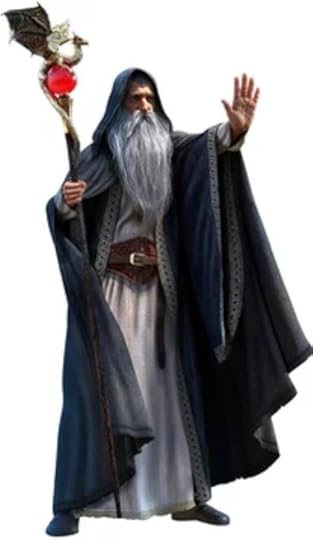
(Art by warpaintcobra)
ClassBaseFortRefWillSpellsPerDayLevelAttackBonusSaveSaveSaveSpecial1st2nd3rd4th5th6th1st+0+2+0+2Pellar pool (counterspell, spell known)1–––––2nd+1+3+0+3Bonus feats2–––––3rd+1+3+1+3Pellar pool (Silent & Still)3–––––4th+2+4+1+431––––5th+2+4+1+4Bonus Feats42––––6th+3+5+2+5Pellar pool (arcane spell)43––––7th+3+5+2+5431–––8th+4+6+2+6Bonus feats442–––9th+4+6+3+6Pellar pool (heighten spell)543–––10th+5+7+3+75431––11th+5+7+3+7Bonus feats5442––12th+6/+1+8+4+8Pellar pool (staves and wands)5543––13th+6/+1+8+4+855431–14th+7/+2+9+4+9Bonus feats55442–15th+7/+2+9+5+9Pellar pool (limited wish)55543–16th+8/+3+10+5+1055543117th+8/+3+10+5+10Bonus feats55544218th+9/+4+11+6+11Pellar pool (wish)55554319th+9/+4+11+6+1155555420th+10/+5+12+6+12Bonus feats, pellar pool (supernatural)555555(More stuff TBD)
CLASS FEATURES
Bonus Feats:
At 2nd level, and at 3rd level thereafter (5th, 8th, 1tth, and so on), a pellar’s study into the workings and methodology of spells and spellcrafting result in gaining two bonus feats in addition to those gained from normal advancement. One is a Practical Spell Study feat, and one is an Esoteric Spell Study feat. The pellar must meet all the prerequisites of any bonus feat selected. However, the player can ignore the flavor text that describes how or why a character might gain, view, or use such a feat as the pellar can always pick things up through dedicated scholarly study.
The Practical Spell Study bonus feat must be selected from the following list:
Any metamagic feat, Ancient Draconic, Augment Summoning, Combat Casting, Diviner’s Delving, Eschew Materials, Expanded Arcana, Extra Cantrips or Orisons, False Focus, Improved Counterspell, Inscribe Magical Tattoo, Greater Spell Penetration, Lunging Spell Touch, Magic Trick, Magical Aptitude, Parry Spell, Scribe Scroll, Shocking Amplification, Skill Focus [Knowledge (arcana), Spellcraft, or Use Magic Device], Spell BluffUM, Spell Denial, Spell Focus, Spell Penetration, Spell Perfection, Spell Specialization, Spontaneous Metafocus, Steadfast Mind, Subtle Enchantments, Wand Dancer, or Weapon Focus (ray).
The Esoteric Spell Study feat must be selected from the following list:
Accursed Critical, Arcane Blast, Arcane Shield, Arcane Talent, Arcane Trap Suppressor, Astrological Timing, Augment Calling, Banish Possessor, Blackfire Summoning, Bloatmage Initiate, Casting Conduit, Conduit Casting, Countering Loophole, Cunning Caster, Eldritch Aid, Elemental Conversion, Emergency Attunement, Expanded Summon Monster, Extended Scrying, Eyes of the Purge, False Casting, Force Dash, Fortune Teller, Ghost Whisperer, Herbal Components, Hidden Presence, Legalistic Reading, Minor Spell Expertise, Nature Magic, Pattern Message, Penetrating Possession, Profane Studies, Proxy Summoning, Putrid Summons, Read Spell Traces, Reflexive Caster, Sacrificial Adept, Sahir-Afiyun, Sacred Summons, Scale and Skin, Scouting Summons, Sense Magical Interrogation, Scrutinize Spell, Shifting Patterns, Spell Chain, Spell Spirit Vision, Stubborn Curse, Stylized Spontaneity, Summon Guardian Spirit, Sunlight Summons, Superior Scryer, Supernatural Tracker, Synergy, Tattoo Attunement, Telepathy Trap, Tenacious Transmutation.
Cancer Support
I have cancer, and am on chemo (and likely will be for months to come). If you want to help me cover cancer treatment costs, right now, one great way to offer your support is to pick up The Traveler’s Guide to the Darklands: For Pathfinder 2E, which a vast number of amazingly talented people put together as a charity product to aid me. And it’s got excepts from Alphonse Lord Tabbington! Also, the product Like A Boss – A Book of Boss Encounters is a community project put together by Samurai Sheepdog to help me cover costs.
Or, if you prefer, I do accept donations to my Ko-Fi, which doesn’t take a cut before passing the money on to me. (Also, there are cat pics there!)
And, of course, a big part of my income comes from people supporting my Patreon, so joining that is a big help!
Bonus Feats for the Thaumaturge: A Pathfinder 1st ed Base Class
I’ve mentioned a few times in the thaumaturge design articles that I wanted to leave lots of room for extra benefits to help set the class apart from sorcerers without making them OP. As a 6-level spellcaster with 1/2 base attack bonus, they definitely need some advantages if they are going to keep up with other classes, and they need some selectable options beyond spells known to help let players customize them.
So, bonus feats time.
I’ve very intentionally taken an unusual approach here, in that the class gains two bonus feats every 3 levels, drawing from two different sets of feat options. There’s a in-game reason for that, stated with the class feature’s entry, but there’s also a less obvious design reason. Feats are not created equal, and a lot of the most interesting ones are significantly lower in total power than some of the feats granting boring bonuses and extra uses.
So, to make sure the class gets the needed spell power, they have a set of practical character-power-boosting feats to pick from. But, each time that happens, they also get to pick from a set of more thematic, generally less universally useful feats. This forces players to take some colorful interesting choices, but not at the expense f the power-ups a class actually needs.

(Art by warpaintcobra)
ClassBaseFortRefWillSpellsPerDayLevelAttackBonusSaveSaveSaveSpecial1st2nd3rd4th5th6th1st+0+2+0+2Thaumaturgy pool (counterspell, spell known)1–––––2nd+1+3+0+3Bonus feats2–––––3rd+1+3+1+3Thaumaturgy pool (Silent & Still)3–––––4th+2+4+1+431––––5th+2+4+1+4Bonus Feats42––––6th+3+5+2+5Thaumaturgy pool (arcane spell)43––––7th+3+5+2+5431–––8th+4+6+2+6Bonus feats442–––9th+4+6+3+6Thaumaturgy pool (heighten spell)543–––10th+5+7+3+75431––11th+5+7+3+7Bonus feats5442––12th+6/+1+8+4+8Thaumaturgy pool (staves and wands)5543––13th+6/+1+8+4+855431–14th+7/+2+9+4+9Bonus feats55442–15th+7/+2+9+5+9Thaumaturgy pool (limited wish)55543–16th+8/+3+10+5+1055543117th+8/+3+10+5+10Bonus feats55544218th+9/+4+11+6+11Thaumaturgy pool (wish)55554319th+9/+4+11+6+1155555420th+10/+5+12+6+12Bonus feats, thaumaturgy pool (supernatural)555555(More stuff TBD)
CLASS FEATURES
Bonus Feats:
At 2nd level, and at 3rd level thereafter (5th, 8th, 1tth, and so on), a thaumaturge’s study into the workings and methodology of spells and spellcrafting result in gaining two bonus feats in addition to those gained from normal advancement. One is a Practical Spell Study feat, and one is an Esoteric Spell Study feat. The thaumaturge must meet all the prerequisites of any bonus feat selected. However, the player can ignore the flavor text that describes how or why a character might gain, view, or use such a feat as the thaumaturge can always pick things up through dedicated scholarly study.
The Practical Spell Study bonus feat must be selected from the following list:
Any metamagic feat, Ancient Draconic, Augment Summoning, Combat Casting, Diviner’s Delving, Eschew Materials, Expanded Arcana, Extra Cantrips or Orisons, False Focus, Improved Counterspell, Inscribe Magical Tattoo, Greater Spell Penetration, Lunging Spell Touch, Magic Trick, Magical Aptitude, Parry Spell, Scribe Scroll, Shocking Amplification, Skill Focus [Knowledge (arcana), Spellcraft, or Use Magic Device], Spell BluffUM, Spell Denial, Spell Focus, Spell Penetration, Spell Perfection, Spell Specialization, Spontaneous Metafocus, Steadfast Mind, Subtle Enchantments, Wand Dancer, or Weapon Focus (ray).
The Esoteric Spell Study feat must be selected from the following list:
Accursed Critical, Arcane Blast, Arcane Shield, Arcane Talent, Arcane Trap Suppressor, Astrological Timing, Augment Calling, Banish Possessor, Blackfire Summoning, Bloatmage Initiate, Casting Conduit, Conduit Casting, Countering Loophole, Cunning Caster, Eldritch Aid, Elemental Conversion, Emergency Attunement, Expanded Summon Monster, Extended Scrying, Eyes of the Purge, False Casting, Force Dash, Fortune Teller, Ghost Whisperer, Herbal Components, Hidden Presence, Legalistic Reading, Minor Spell Expertise, Nature Magic, Pattern Message, Penetrating Possession, Profane Studies, Proxy Summoning, Putrid Summons, Read Spell Traces, Reflexive Caster, Sacrificial Adept, Sahir-Afiyun, Sacred Summons, Scale and Skin, Scouting Summons, Sense Magical Interrogation, Scrutinize Spell, Shifting Patterns, Spell Chain, Spell Spirit Vision, Stubborn Curse, Stylized Spontaneity, Summon Guardian Spirit, Sunlight Summons, Superior Scryer, Supernatural Tracker, Synergy, Tattoo Attunement, Telepathy Trap, Tenacious Transmutation.
Cancer Support
I have cancer, and am on chemo (and likely will be for months to come). If you want to help me cover cancer treatment costs, right now, one great way to offer your support is to pick up The Traveler’s Guide to the Darklands: For Pathfinder 2E, which a vast number of amazingly talented people put together as a charity product to aid me. And it’s got excepts from Alphonse Lord Tabbington! Also, the product Like A Boss – A Book of Boss Encounters is a community project put together by Samurai Sheepdog to help me cover costs.
Or, if you prefer, I do accept donations to my Ko-Fi, which doesn’t take a cut before passing the money on to me. (Also, there are cat pics there!)
And, of course, a big part of my income comes from people supporting my Patreon, so joining that is a big help!
Owen K.C. Stephens's Blog
- Owen K.C. Stephens's profile
- 7 followers



